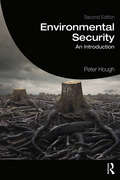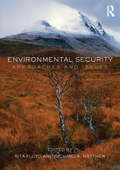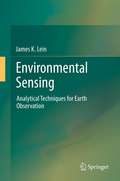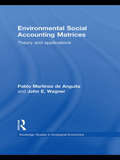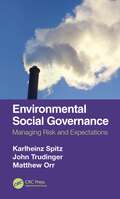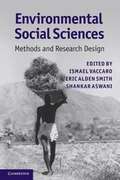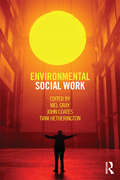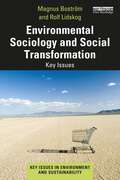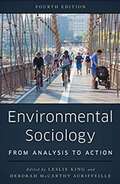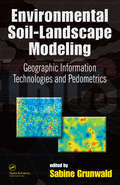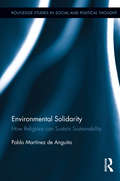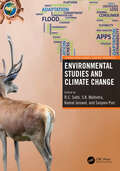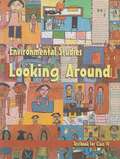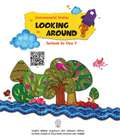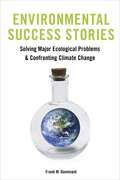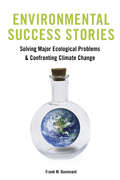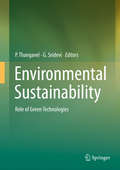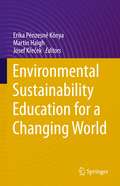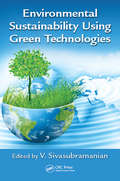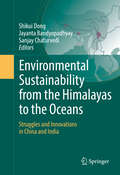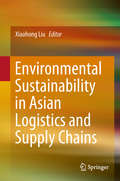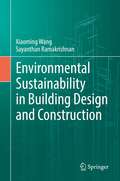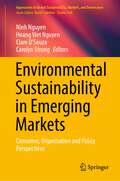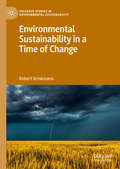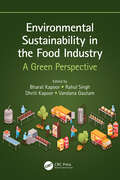- Table View
- List View
Environmental Security: An Introduction
by Peter HoughThis textbook offers a student-friendly survey of the global politics of the environment through the prism of security studies. This book is divided into three thematic sections. The first part sets out the key theoretical and practical arguments for and against bringing together environmental and security issues. The second part examines why environmental issues have been framed by some as ‘national security‘ concerns in the context of the effects of overpopulation, resource depletion, climate change and the role of the military as both a cause and a solution to problems of pollution and natural disasters. Finally, the third section explores the case for treating the key issues of environmental change as matters of human security. The chapters have been updated to include the 2015 Paris Climate Change Accords, the Trump and Sendai Framework for Disaster Risk Reduction, and there is a new chapter on environmental history. Overall, the book provides a clear, systematic and thorough overview of an area of great academic and ‘real-world’ political interest. This book will be essential reading for students of environmental studies, critical and human security, human geography, development studies, and International Relations in general.
Environmental Security: Approaches and Issues
by Rita Floyd Richard MatthewEconomic development, population growth and poor resource management have combined to alter the planet’s natural environment in dramatic and alarming ways. For over twenty years, considerable research and debate have focused on clarifying or disputing linkages between various forms of environmental change and various understandings of security. At one extreme lie sceptics who contend that the linkages are weak or even non-existent; they are simply attempts to harness the resources of the security arena to an environmental agenda. At the other extreme lie those who believe that these linkages may be the most important drivers of security in the 21st century; indeed, the very future of humankind may be at stake. This book brings together contributions from a range of disciplines to present a critical and comprehensive overview of the research and debate linking environmental factors to security. It provides a framework for representing and understanding key areas of intellectual convergence and disagreement, clarifying achievements of the research as well as identifying its weaknesses and gaps. Part I explores the various ways environmental change and security have been linked, and provides principal critiques of this linkage. Part II explores the linkage through analysis of key issue areas such as climate change, energy, water, food, population, and development. Finally, the book concludes with a discussion of the value of this subfield of security studies, and with some ideas about the questions it might profitably address in the future. This volume is the first to provide a comprehensive overview of the field. With contributions from around the world, it combines established and emerging scholars to offer a platform for the next wave of research and policy activity. It is invaluable for both students and practitioners interested in international relations, environment studies and human geography.
Environmental Sensing
by James K. LeinRemote sensing has witnessed a renaissance as new sensor systems, data collection capabilities and image processing methodologies have expanded the technological capabilities of this science into new and important applications areas. Perhaps nowhere has this trend been more evident than in the study of earth environments. Within this broad application area remote sensing has proven to be an invaluable asset supporting timely data gathering at a range of synoptic scales, facilitating the mapping of complex landscapes and promoting the analysis of environmental process. Yet remote sensing's contribution to the study of human/environmental interaction is scattered throughout a rich and diverse literature spanning the social and physical sciences, which frustrates access to, and the sharing of the knowledge gained through, these recent advances, and inhibits the operational use of these methods and techniques in day to day environmental practice, a recognized gap that reduces the effectiveness of environmental management programs. The objective of this book is to address this gap and provide the synthesis of method and application that is currently missing in the environmental science, re-introducing remote sensing as an important decision-support technology.
Environmental Social Accounting Matrices: Theory and Applications (Routledge Studies in Ecological Economics #7)
by John E. Wagner Pablo Martínez de AnguitaIn this book Professors Pablo Martínez de Anguita and John E. Wagner put two disciplines together, regional and ecological economics, presenting a way to understand ecological economic concerns from a regional perspective, and providing a mathematical tool to measure their interrelationships. This book offers different regional economic models that explicitly include the role of the natural resources and pollutants in economic regions through the use of Social Accounting Matrixes and Input-output models. The main objective of this book is to explore Input-output and Social Accounting Matrix (SAM) models by expanding the accounts to include natural resources and the environment. The proposed models in this book incorporate the forest and other natural resources and pollutants as a component in a larger model of how the economy and environment of larger areas interact. This book will be of interests to postgraduates, researchers and scientists in the fields of regional, resource, environmental, or ecological economics.
Environmental Social Governance: Managing Risk and Expectations
by Karlheinz Spitz John Trudinger Matthew OrrIncreasingly, companies are being judged by their performance in terms of Environmental Social Governance (ESG). But exactly what does it mean, and what should be done about it? While much ambiguity exists, it is no longer sufficient to negotiate the environmental assessment process successfully. ESG is an ongoing process that spans the entire life cycle of a company and its operations. This book is aimed at business leaders – senior executives and company directors – and particularly those involved in the extractive industries and other ventures that significantly affect the environment and host communities. Guidance is provided on the major ESG issues that confront all business leaders. Strategies are provided to address ESG risk and to handle crises when they occur. QUESTIONS FOR BUSINESS LEADERS: Are you at all prepared for an environmental or social crisis event? How will you cope with the "unknown unknowns"? What do your shareholders expect you to do about climate change? Are your employees proud of the company’s ESG performance? How does your bank evaluate your biodiversity impacts?
Environmental Social Sciences: Methods and Research Design
by Ismael Vaccaro Eric Alden Smith Shankar AswaniThe relationship between human communities and the environment is extremely complex. In order to resolve the issues involved with this relationship, interdisciplinary research combining natural sciences, social sciences, and humanities is necessary. Here, specialists summarise methods and research strategies for various aspects of social research devoted to environmental issues. Each chapter is illustrated with ethnographic and environmental examples, ranging from Australia to Amazonia, from Madagascar to the United States, and from prehistoric and historic cases to contemporary rural and urban ones. It deals with climate change, deforestation, environmental knowledge, natural reserves, politics and ownership of natural resources, and the effect of differing spatial and temporal scales. Contributing to the intellectual project of interdisciplinary environmental social science, this book shows the possibilities social science can provide to environmental studies and to larger global problems and thus will be of equal interest to social and natural scientists and policy makers.
Environmental Social Work: Racial Preference In Black And White (Positions: Education, Politics, And Culture Ser.)
by Tim J. WiseSocial work has been late to engage with the environmental movement. Often working with an exclusively social understanding of environment, much of the social work profession has overlooked the importance of environmental issues. However, recently, the impact of and worldwide attention to climate change, a string of natural disasters, and increased understanding of issues around environmental justice has put the environment, sustainability, and well-being in the spotlight. Divided into three parts, this field-defining work explores what environmental social work is, and how it can be put into practice. The first section focuses on theory, discussing ecological and social justice, as well as sustainability, spirituality and human rights. The second section comprises case studies of evolving environmental social work practice. The case studies derive from a range of areas from urban gardens and community organizing to practice with those affected by climate change. The final section – relevant to students and lecturers – looks at learning about environmental issues in social work. Environmental Social Work provides an integrated theoretical and practical overview of why and how social work might respond to environmental factors affecting the societies and people they work with at international, national, local and individual levels.
Environmental Sociology and Social Transformation: Key Issues (ISSN)
by Rolf Lidskog Magnus BoströmEnvironmental Sociology and Social Transformation demonstrates how sociological theory and research are critical for understanding the social drivers of global environmental destruction and the conditions for transformative change.Written by two professors of sociology who are deeply involved in the international community of environmental sociology, Magnus Boström and Rolf Lidskog argue that we need to better understand society as well as the fundamentally social nature of environmental problems and how they can be addressed. The authors provide answers to why so many unsustainable practices are maintained and supported by institutions and actors despite widespread knowledge of their negative consequences. Employing a pluralistic sociological approach to the study of social transformations, the book is divided into five key themes: Causes, Distributions, Understandings, Barriers, and Transformation. Overall, the book offers an integrative and comprehensive understanding of the social dimension of (un)sustainability, societal inertia, and conditions for transformative change. It provides the reader with references from classic and contemporary sociology and uses pedagogical features including boxes and questions for discussion to help embed learning.Arguing that a broad and deep social transformation is needed to avoid a global civilization crisis, Environmental Sociology and Social Transformation will be a great resource for students and scholars who are exploring current environmental challenges and the societal conditions for meeting them.
Environmental Sociology: From Analysis to Action (G - Reference, Information and Interdisciplinary Subjects Series)
by Leslie King Deborah McCarthy AuriffeilleEnvironmental Sociology: From Analysis to Action illustrates how sociological perspectives can help us better understand the causes and consequences of environmental problems and provides examples of efforts to ameliorate these problems. <p><p>The fourth edition of this environmental sociology reader includes 22 edited excerpts (10 of them new to this edition) that address, among other things, environmental inequalities, knowledge creation, media, and perspectives on disaster. The selected pieces use a variety of sociological perspectives, including environmental justice, power structure research, ecological modernization, ecological footprint, and more, to examine a wide range of environment-related topics.
Environmental Soil-Landscape Modeling: Geographic Information Technologies and Pedometrics
by Sabine GrunwaldEnvironmental Soil-Landscape Modeling: Geographic Information Technologies and Pedometrics presents the latest methodological developments in soil-landscape modeling. It analyzes many recently developed measurement tools, and explains computer-related and pedometric techniques that are invaluable in the modeling process.This volume provi
Environmental Solidarity: How Religions Can Sustain Sustainability (Routledge Studies in Social and Political Thought)
by Pablo Martínez de AnguitaThe past few decades have seen the beginnings of a convergence between religions and ecological movements. The environmental crisis has called the religions of the world to respond by finding their voice within the larger Earth community. At the same time, a certain religiosity has started to emerge in some areas of secular ecological thinking. Beyond mere religious utilitarianism, rooted in an understanding of the deepest connections between human beings, their worldviews, and nature itself, this book tries to show how religious believers can look at the world through the eyes of faith and find a broader paradigm to sustain sustainability, proposing a model for transposing this paradigm into practice, so as to develop long-term sustainable solutions that can be tested against reality.
Environmental Studies and Climate Change (Translating Animal Science Research)
by S. K. Malhotra Sanjeev Puri R. C. Sobti Kamal JaiswalCurrently, anthropogenic activities have caused unprecedented destruction of the environment at alarming rates, leading to undesirable alterations in air, land, and water. The process of environment degradation has been accelerated by industrial processes, which result in waste as well as over-consumption of natural resources. The ecological balance has been disturbed, and resources have shrunk. All this has resulted in climate change, which has emerged as a major concern in the 21st century. Changes in the environment are driven by demand for energy, water, and food to raise the standard of living. These are also responsible for climate change, with contributions from deforestation and CO2 emissions from fossil fuels such as coal and petroleum. The present volume discusses some of the main issues regarding environmental degradation and the causes as well as the impact of climate change, which is impacting the ecosystem. The effects of various pollutants, causes of climate change with case studies on geochemistry and glaciers, etc., and measures to reduce the impact on biodiversity, health, etc. are discussed in detail in its chapters. In a nutshell, this volume discusses in detail the following issues: • Anthropogenic and natural factors in environmental degradation • Climate change history, causes, and threats to abiotic and biotic systems • Case studies on the impact of climate change and living systems • Mitigation and preparedness for the future
Environmental Studies: Looking Around class 4 - NCERT - 23
by National Council of Educational Research and TrainingThe NCERT textbook "Environmental Studies - Looking Around" for Class IV provides a comprehensive introduction to environmental awareness for young learners. The book aims to instill a sense of responsibility and appreciation for the natural world among students. Through engaging narratives, colorful illustrations, and interactive activities, it covers diverse topics such as the importance of water, air, and soil, biodiversity, and the significance of conservation. The content is presented in a child-friendly manner, encouraging students to observe and understand their surroundings. The textbook not only imparts knowledge about the environment but also encourages students to develop a sustainable and eco-friendly mindset. With a focus on fostering curiosity and a sense of wonder, "Environmental Studies - Looking Around" serves as a valuable resource for nurturing environmentally conscious citizens from an early age.
Environmental Studies: Looking Around class 5 - NCERT - 23
by National Council of Educational Research and TrainingThis a textbook for Class V Environmental Studies, published by the National Council of Educational Research and Training (NCERT) in India. It covers six themes related to the natural and social environment of children, such as family and friends, food, water, shelter, travel, and things we make and do. The textbook aims to link children’s life at school with their life outside the school, and to encourage them to observe, explore, question, and experiment with their surroundings. The textbook also tries to develop children’s sensitivity towards the diversity and interdependence of life forms, and to foster a concern for justice and equality in society. The textbook consists of 22 chapters, each with activities, illustrations, and questions for assessment. The textbook follows the guidelines of the National Curriculum Framework (2005) and the syllabus designed by NCERT for primary level education.
Environmental Success Stories: Solving Major Ecological Problems And Confronting Climate Change
by Kari Marie Norgaard Frank DunnivantUnlike many titles on environmental issues that portend a dark future, Environmental Success Stories delves into the most daunting ecological and environmental challenges humankind has faced and shows how scientists, citizens, and a responsive public sector have dealt with them successfully. <P><P> In addition to presenting the basic chemical and environmental science underlying problems like providing clean drinking water, removing DDT and lead from agriculture and our homes, and curtailing industrial pollution, this book also discusses the political actors, agency regulators, and community leaders who have collaborated to enact effective legislation. Sharing the stories of the people, organizations, and governments who have addressed these problems successfully, Frank M. Dunnivant explains how we might confront the world's largest and most complex environmental crisis: climate change. Now is the time for rededicated scientific exploration and enlightened citizen action to save our environment, and Dunnivant's book offers a stirring call to action.
Environmental Success Stories: Solving Major Ecological Problems and Confronting Climate Change
by Frank DunnivantUnlike many titles on environmental issues that portend a dark future, Environmental Success Stories delves into the most daunting ecological and environmental challenges humankind has faced and shows how scientists, citizens, and a responsive public sector have dealt with them successfully.In addition to presenting the basic chemical and environmental science underlying problems like providing clean drinking water, removing DDT and lead from agriculture and our homes, and curtailing industrial pollution, this book also discusses the political actors, agency regulators, and community leaders who have collaborated to enact effective legislation. Sharing the stories of the people, organizations, and governments who have addressed these problems successfully, Frank M. Dunnivant explains how we might confront the world's largest and most complex environmental crisis: climate change. Now is the time for rededicated scientific exploration and enlightened citizen action to save our environment, and Dunnivant's book offers a stirring call to action.
Environmental Sustainability
by P. Thangavel G. SrideviCovers different categories of green technologies (e. g. biofuels, renewable energy sources, phytoremediation etc. ,) in a nutshell -Focuses on next generation technologies which will help to attain the sustainable development -The chapters widely cover for students, faculties and researchers in the scientific arena of Environmentalists, Agriculturalists, Engineers and Policy Makers The World Environment Day 2012 is prepared to embrace green economy. The theme for 2012 encompasses various aspects of human living, ranging from transport to energy to food to sustainable livelihood. Green technology, an eco-friendly clean technology contributes to sustainable development to conserve the natural resources and environment which will meet the demands of the present and future generations. The proposed book mainly focuses on renewable energy sources, organic farming practices, phyto/bioremediation of contaminants, biofuels, green buildings and green chemistry. All of these eco-friendly technologies will help to reduce the amount of waste and pollution and enhance the nation's economic growth in a sustainable manner. This book is aimed to provide an integrated approach to sustainable environment and it will be of interest not only to environmentalists but also to agriculturists, soil scientists and bridge the gap between the scientists and policy-makers.
Environmental Sustainability Education for a Changing World
by Josef Křeček Martin Haigh Erika Pénzesné KónyaGlobally, there is a need to promote and empower practical action towards better environmental conservation and greater sustainability; education aspires to achieve and motivate this – one mind at a time. This book advances a future-oriented vision of the development of environmental sustainability education in settings outside the high-school. It provides practical guidance for teacher practitioners and policy makers in community-oriented environmental sustainability education. It promotes a modern holistic approach to sustainability learning in and by the community through participative engagement with sustainability issues. Its special foci include working with volunteers and citizen scientists, through museums or through re-purposing Higher Education. Its approach emphasises the implementation of the United Nation’s Sustainable Development Goals and cooperation with environmental management professionals. This book’s cosponsors include the International Association for Headwater Control and FAO – European Forestry Commission’s Working Party on the Management of Mountain Watersheds, as well as the International Environmental Education Conferences, Eger, Hungary and the Hungarian Academy of Science’s Subcommittee on Future Studies. Community education has long been a goal for environmental management, whose practitioners realise that interventions, such as biodiversity conservation, are only truly sustainable when supported by the local land-user and stakeholder communities; this depends upon these stakeholders’ understanding why intervention is necessary.
Environmental Sustainability Using Green Technologies
by V. SivasubramanianEnvironmental Sustainability Using Green Technologies explains the role of green engineering and social responsibility in the development of chemicals, processes, products, and systems. Examining the relationship between economy, ecology, and equality—key factors in developing a sustainable society—this book covers several aspects of environmental sustainability, explores ways to use resources and processes more responsibly, and describes the tools required to overcome various challenges. It outlines the biotechnological applications, techniques, and processes needed to secure sustainable development and ensure long-lasting future success. Insightful and highly comprehensive, this body of work addresses: Wastewater treatment technologies Nanomaterials in environmental applications Green synthesis of ecofriendly nanoparticles The role of phytoremediation in maintaining environmental sustainability Algal biosorption of heavy metals Mass production of microalgae for industrial applications Integrated biological system for the treatment of sulfate rich wastewater Anaerobic digestion of pharmaceutical effluent Treatment of textile dye using bioaccumulation techniques Production of biosurfactants and their applications in bioremediation Biodegradable polymers Microbial fuel cell (MFC) technology Biodiesel from nonedible oil using a packed bed membrane reactor Production of ecofriendly biodiesel from marine sources Pretreatment techniques for the enhancement of biogas production A review of source apportionment of air pollutants by receptor models and more Environmental Sustainability Using Green Technologies provides excellent reference material that aids and supports sustainability, and offers practical guidance for professors, research scholars, industrialists, biotechnologists, and workers in the applied field of environmental engineering.
Environmental Sustainability from the Himalayas to the Oceans
by Shikui Dong Sanjay Chaturvedi Jayanta BandyopadhyayThe book is written in the backdrop of the environmental impacts of and future requirements from the natural environment for rapid economic growth that has characterized recent economic history of China and India, especially over the past few decades. The environmental impacts of such rapid economic changes have been, more frequently than otherwise, degrading in character. Environmental impacts of economic activities create degraded natural ecosystems by over utilization of nature's provisioning ecosystem services (from Himalaya to the Ocean), as well, by the use of the natural environment as sink for dumping of unmarketable products or unused inputs of economic activities. Such processes affect wide range of ecosystem processes on which the natural environment including human population depend on. Critical perspectives cast by various chapters in this book draw attention to the various ways in which space and power interact to produce diverse geographies of sustainability in a globalizing world. They also address the questions such as who decides what kind of a spatial arrangement of political power is needed for sustaining the environment. Who stands to gain (or lose) what, when, where, and why from certain geographical areas being demarcated as ecologically unique, fragile and vulnerable environments? Whose needs and values are being catered to by a given ecosystem service? What is the scope for critical inquiry into the ways in which the environment is imagined, represented and resisted in both geopolitical struggles and everyday life? The book provides insights to both academics from diverse disciplines and policy makers, civil society actors interested in mutual exchange of knowledge between China and India.
Environmental Sustainability in Asian Logistics and Supply Chains
by Xiaohong LiuThis book gathers together invited presentations from the 12th International Congress on Logistics and SCM Systems (ICLS2017) held in Beijing, China, August 20–23, 2017. The focus of the ICLS2017 was environmental sustainability in logistics and supply chains, particularly in the Asia-Pacific region. It addressed a variety of themes in the domains of green logistics and supply chain management (SCM), including green logistics and environmental impact, green SCM and business performance, green operations and optimization, supply chain sustainability, carbon management in logistics, and green SCM and corporate social responsibility (CSR). The editors selected high-quality presentations from the highly successful symposium, and invited the presenters to prepare full chapters for this book in order to disseminate their findings and promote further research collaborations. This timely book sheds new light on the theories and practices associated with greening logistics and SCM in Asia.
Environmental Sustainability in Building Design and Construction
by Xiaoming Wang Sayanthan RamakrishnanThis monograph offers analyses of construction activities using various key concepts and assessments of sustainable development, and provides students and researchers with methodologies and design aspects for the sustainable development of the built environment. Additionally, the book demonstrates various national and international policies for assisting architects, engineers and policy makers in understanding the relevant decision-making approaches to sustainable development in construction. The book begins by reviewing the background of sustainability and sustainable development. The focus then turns to the effects of climate change on the built environment, including impacts of energy and carbon emissions, as well as constraints on water and waste management. The remaining chapters discuss the necessary approaches to achieve sustainable waste management, energy efficient building design, and resilience and adaptation in the built environment In eight chapters, the book encourages readers to think independently, logically and objectively about the complex issues presented by the applications of sustainable development in construction, including resource efficiency, environmental impacts, human health, building economics and social development.
Environmental Sustainability in Emerging Markets: Consumer, Organisation and Policy Perspectives (Approaches to Global Sustainability, Markets, and Governance)
by Carolyn Strong Ninh Nguyen Hoang Viet Nguyen Clare D’SouzaIncreasing evidence of environmental deterioration in emerging markets, climate change, and consequences of environmental waste have compelled not only businesses but also consumers to reduce the environmental burden, mitigate waste and preserve resources for future generations. What actions, strategies, practices, and policies can be developed to sustain environmental sustainability in emerging markets? This book brings together fresh insights, ideas, and new research directions. This book consists of eleven chapters which examine environmental sustainability from consumer, organisation and policy perspectives. These chapters are contributed by emerging and eminent authors from different regions of the world including Asia, Australia, Europe, North America, and South America. This book provides an insightful and valuable compendium for sustainability researchers, businesses, educators, and policymakers, and readers concerned about socio-environmental issues and sustainable development. The book provides policymakers and businesses with information to assist the development of policies, strategies, and programs which will develop and encourage environmentally sustainable behaviours and practices in emerging markets and the wider global community
Environmental Sustainability in a Time of Change (Palgrave Studies in Environmental Sustainability)
by Robert BrinkmannEnvironmental Sustainability in a Time of Change is the first book in a new Palgrave series on Environmental Sustainability. It takes a fresh look at the dynamic field of environmental sustainability by exploring the interconnections between climate change, water, energy, waste, land use, ecosystems, food, and transportation. It also provides an extensive summary on sustainability management, data analysis, mapping, and data sources. Brinkmann highlights how environmental sustainability challenges are distinctly different in the developed world, where sustainability is largely a choice, versus the developing world, where many struggle with basic existence due to war, migration, and water or food scarcity. He takes a broad systems and historic approach to contextualize environmental sustainability prior to the 1987 Brundtland Report and utilizes many contemporary examples throughout the text, analyzing numerous case studies from many areas of the world including China, Yemen, Malaysia, Egypt, and Florida. This book questions traditional approaches to sustainability that highlight the need for an equal balance of economic development, environmental protection, and social equality to achieve sustainability. This book focuses on a new line of thinking that places environmental sustainability as the key foundation in how to manage sustainability in a time of change. Our planet is quickly becoming environmentally unsustainable due to global consumption and unsustainable economic development and it is high time for a fresh approach. This book will be of great value to academics, practitioners, and students interested in environmental sustainability from a myriad of fields including geology, geography, biology, ecology, economics, business, sociology, anthropology, and other areas that intersect the interdisciplinary field of sustainability.
Environmental Sustainability in the Food Industry: A Green Perspective
by Rahul Singh Bharat Kapoor Dhriti KapoorCriticisms facing the food processing industry include adverse ecological impacts like decline in biodiversity, environmental degradation, water pollution, eutrophication, greenhouse gas emissions, and the loss of agricultural land. Environmental Sustainability in the Food Industry: A Green Perspective delves into the effect of food processing on the environment, human health, nutrition, energy efficiency, nanotechnology in food industry, and the maintenance of ecological sustainability. The book presents eco-friendly approaches to reducing the impacts of food processing on the environment and to promoting sustainable development. The focus of this text is how to implement green practices in the food industry to reduce the negative impacts of food processing on the ecosystem, as well as to improve food quality for better human health and nutrition. The text also explains the food industry’s focus on sustainable aspects in resource conservation and reduction of energy consumption. Key Features: Describes the contribution of the food industry sector on human health and nutrition Covers eco-friendly approaches to reducing negative impacts of food processing on the environment Discusses the uses of advanced techniques such as nanotechnology, non-thermal techniques, and more to improve food processing The book highlights details related to the food industry and environmental issues. It is a great resource for students, researchers, and professionals alike, as well as anyone with an interest in green paths to food quality and nutrition.
